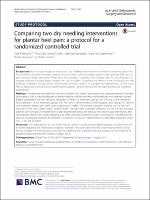Por favor, use este identificador para citar o enlazar este ítem:
https://repositorio.usj.es/handle/123456789/263
Registro completo de metadatos
| Campo DC | Valor | Lengua/Idioma |
|---|---|---|
| dc.contributor.author | Al-Boloushi, Zaid | - |
| dc.contributor.author | Gómez-Trullén, Eva María | - |
| dc.contributor.author | Bellosta-López, Pablo | - |
| dc.contributor.author | López-Royo, María Pilar | - |
| dc.contributor.author | Fernández, Daniel | - |
| dc.contributor.author | Herrero Gállego, Pablo | - |
| dc.date.accessioned | 2019-12-11T14:05:29Z | - |
| dc.date.available | 2019-12-11T14:05:29Z | - |
| dc.date.issued | 2019-01-25 | - |
| dc.identifier.citation | Al-Boloushi, Z., Gómez-Trullén, E., Bellosta-López, P. et al. Comparing two dry needling interventions for plantar heel pain: a protocol for a randomized controlled trial. J Orthop Surg Res 14, 31 (2019) doi:10.1186/s13018-019-1066-4 | es_ES |
| dc.identifier.issn | 1749-799X | es_ES |
| dc.identifier.uri | https://repositorio.usj.es/handle/123456789/263 | - |
| dc.description.abstract | Background Both manual therapy techniques and dry needling have shown to be effective treatment options for the treatment of plantar heel pain; however, in recent years, other techniques based on dry needling (DN), such as percutaneous needle electrolysis (PNE), have also emerged. Currently, PNE is being used in clinical practice to manage myofascial trigger points, despite the lack of studies comparing the effects of this technique over dry needling. Therefore, the aim of this randomized controlled study is to compare the effectiveness of DN versus PNE for improving the level of pain experienced by patients suffering from plantar heel pain provoked by myofascial trigger points. Methods A randomized controlled trial will be conducted with blinded participants and outcome assessors. A sample of 94 patients with a medical diagnosis of plantar heel pain will be recruited and divided into two treatment groups. Eligible participants will be randomly allocated to either (a) treatment group with DN and a self-stretching home program or (b) treatment group with PNE and a self-stretching home program. Each group will receive one treatment session per week over a period of 4 weeks. The primary outcome measure will be the pain subscale of the Foot Health Status Questionnaire. The secondary outcome measures will be a visual analogue scale for pain (average and highest level of pain experienced during the previous 48 h; level of pain immediately after the treatment session) and health-related quality of life (assessed using the EuroQoL-5 dimensions). Cost-effectiveness data will be extracted based on the EuroQoL-5 dimensions. Follow-up measurements will take place at baseline and at 4, 8, 12, 26, and 52 weeks. Discussion The justification for this trial is the need to improve current understanding regarding the effectiveness of treatments targeting the rehabilitation of plantar heel pain. This study will be the first randomized controlled trial to directly compare the effectiveness of DN and PNE combined with a specific stretching program for the treatment of plantar heel pain provoked by myofascial trigger points. | es_ES |
| dc.format.extent | 8 p. | es_ES |
| dc.format.mimetype | application/pdf | es_ES |
| dc.language.iso | eng | es_ES |
| dc.publisher | Springer Nature | es_ES |
| dc.rights | Atribución 4.0 Internacional | * |
| dc.rights.uri | http://creativecommons.org/licenses/by/4.0/ | * |
| dc.subject | Plantar heel pain | es_ES |
| dc.subject | Myofascial trigger points | es_ES |
| dc.subject | Dry needling | es_ES |
| dc.subject | Self-stretchingprotocol | es_ES |
| dc.subject | Percutaneous needle electrolysis | es_ES |
| dc.subject | Cost-effectiveness | es_ES |
| dc.title | Comparing two dry needling interventionsfor plantar heel pain: a protocol for arandomized controlled trial | es_ES |
| dc.type | info:eu-repo/semantics/article | es_ES |
| dc.subject.unesco | Ensayo | es_ES |
| dc.relation.publisherversion | https://josr-online.biomedcentral.com/track/pdf/10.1186/s13018-019-1066-4 | es_ES |
| dc.identifier.doi | https://doi.org/10.1186/s13018-019-1066-4 | es_ES |
| dc.rights.accessrights | info:eu-repo/semantics/openAccess | es_ES |
| Aparece en las colecciones: | Artículos de revistas | |
Ficheros en este ítem:
| Fichero | Descripción | Tamaño | Formato | |
|---|---|---|---|---|
| Comparing two dry needling interventions for plantar heel pain.pdf | 1,15 MB | Adobe PDF |  Visualizar/Abrir |
Este ítem está sujeto a una licencia Creative Commons Licencia Creative Commons

